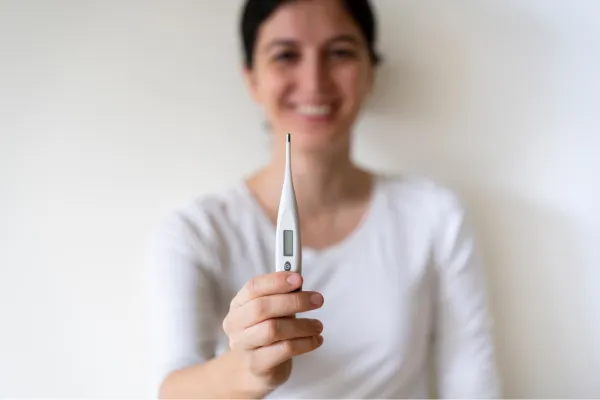
Understanding Body Temperature Changes During the Menstrual Cycle
The menstrual cycle is a powerful indicator of your body’s overall health, with each phase offering insights into your hormonal balance and well-being. One of the key physiological changes during the cycle is body temperature variation. By understanding these temperature fluctuations, you can gain valuable information about your fertility, hormonal health, and overall cycle patterns. This post will explore how and why your body temperature changes throughout the menstrual cycle, and how tracking these changes can support your menstrual health.
The Basics of Basal Body Temperature (BBT)
Basal Body Temperature (BBT) refers to your body’s lowest resting temperature, to be measured first thing in the morning before any activity. BBT is a reliable indicator of hormonal shifts during the menstrual cycle, particularly in relation to ovulation. Tracking BBT can give you necessary information if you are trying to conceive, avoid pregnancy, or simply better understand their menstrual health.
Body Temperature During the Menstrual Cycle
1. The Follicular Phase: The menstrual cycle begins with the follicular phase, which starts on the first day of menstruation and ends with ovulation. During this phase, estrogen levels gradually rise, preparing the body for ovulation. Throughout the follicular phase, BBT remains relatively low, typically ranging between 97.0°F to 97.5°F (36.1°C to 36.4°C). This lower temperature is maintained until just before ovulation.
2. Ovulation: Ovulation marks the midpoint of the menstrual cycle and is characterized by the release of an egg from the ovary. During ovulation, the hormone progesterone is released, which causes a slight increase in BBT. This rise in temperature is often around 0.5°F to 1.0°F (0.3°C to 0.6°C) and typically occurs within 24 hours after ovulation. The temperature shift indicates that ovulation has occurred, and the fertile window has passed.
3. The Luteal Phase: Following ovulation, the luteal phase begins. During this phase, progesterone remains elevated, keeping BBT higher than during the follicular phase. BBT typically stays elevated for the duration of the luteal phase, which lasts about 10 to 14 days. This sustained temperature increase is due to progesterone's thermogenic effect, which helps maintain a warm environment for a potential pregnancy. If pregnancy does not occur, progesterone levels drop, leading to a decrease in BBT.
4. Menstruation: As the luteal phase ends and menstruation begins, progesterone levels decrease, causing BBT to drop back to its baseline level. This temperature drop signals the start of a new cycle.
Why Track Your Basal Body Temperature?
Tracking BBT is a simple yet effective way to gain insights into your menstrual health. By consistently recording your BBT, you can identify patterns in your cycle, confirm ovulation, and better understand your hormonal balance. This information is particularly valuable for those trying to conceive, as pinpointing the exact time of ovulation can increase the chances of pregnancy. Additionally, BBT tracking can help identify potential issues such as luteal phase defects or anovulation (when ovulation does not occur).
Tips for Accurate BBT Tracking:
Consistency is key: Take your BBT at the same time every morning, immediately after waking up, and before any physical activity. (If you miss a day or two, it's ok. Being consistent doesn't mean being perfect. If you make note of your BBT on most days, you will have enough information to understand the changes during your menstrual cycle.)
Use a reliable thermometer: A digital BBT thermometer is more accurate than a regular thermometer, as it measures temperature to the hundredth of a degree.
Track for Several Cycles: To get a clear picture of your cycle patterns, track your BBT for at least three consecutive cycles.
Start tracking as soon as tomorrow morning
BBT tracking is a powerful tool for enhancing your menstrual awareness and overall health. Whether you're tracking for fertility purposes or simply to gain better insights into your cycle, monitoring your BBT can provide valuable information about your body's rhythms. By incorporating BBT tracking into your menstrual health routine, you can take a proactive approach to understanding and managing your hormonal health.
Curious to learn more about how your menstrual cycle affects your overall well-being? Explore my Free Resources to dive deeper into menstrual cycle awareness and homeopathy for hormonal balance.
